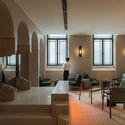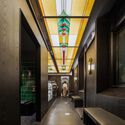
-
Architects: Wutopia Lab
- Area: 170 m²
- Year: 2022
-
Photographs:CreatAR Images

Coffee and Shanghai - You can find Japanese, Korean, American, Taiwanese, or Southeast Asian cafés, and you can even find a run-down but proudly maintained 1980s Taiwanese Japanese café on Yongkang Road, but there is no such one that represents Shanghai. However, Shanghai has a long history of cafés. In Eileen Chang's essay "Double Voices" published in Tiandi magazine in 1945, she began by saying that when she went out with her friends, no matter what they did, they would always end up in a café. At that time, cafés in Shanghai were communal spaces in the city, serving beverages and snacks, but they could also be dancing halls, meeting rooms, libraries, information centers, and everyday social places.










































